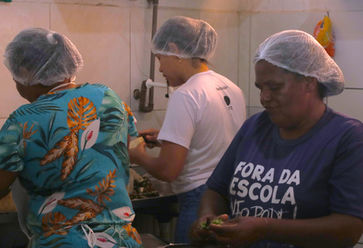

Social technology aimed at food security in schools, employing data science and promoting protagonism and integration between school cooks and family farmers in the region to provide healthy and nutritious meals for all children and adolescents.
Current Status
To optimize the management of school meals, we are working on implementing new features in the TAG system, integrating it with our NHAM app. This integration will bring more agility and accuracy to the information.
At the same time, NHAM will invest energy in creating a recipe book specially developed for school meals. The goal is to offer tasty, nutritious options that encourage healthy eating habits from childhood. The material will be a practical and inspiring guide, using optimized preparation methods and ingredients that are already part of the school menu.


















Historic
The development of NHAM began in 2021 as a natural demand from TS Hb, aiming at diagnose and overcome iron deficiency anemia in schools, which the main cause lies in unhealthy diet.
NHAM integrates TAG and Hb Social Technologies. Hb collects data on weight, height and hemoglobin level in the blood, which makes it possible to assess malnutrition or obesity and whether the student has iron deficiency anemia. In other words, Hb guides the need for special nutrition for groups of students, who started to be monitored. In the case of TAG, we have food stock control, control of students' attendance at school and the creation of menus, under the supervision of the municipality's nutritionist. This information, in turn, helps in the integration between demand from schools and supply from family farming, making it possible to guide planning for planting and marketing the production of family farmers, through the National School Feeding Program (PNAE).
In 2022, NHAM sought to strengthen the role of the school cooks as educational agents in Food Safety and Nutrition, through training cycles and development of support materials on the topic. In the same year, school cooks applied as instrument to diagnose the degree of acceptability of school meals by students, serving as a basis for preparing school menus. Finally, a new functionality for managing students' school attendance was developed to support school cooks in preparing meals. In 2023, NHAM continued with acceptability tests in four schools in Santa Luzia do Itanhy. Furthermore, in partnership with the TAG team, the cortex equipment was tested, developed by the team to use biometrics to control students' attendance at school and the students' menu, aiming to reduce food wasting. During this year, we had the collaboration of 13 school cooks, resulting in direct benefits for 90 children, 55 teachers and 101 families, in addition to indirectly impacting around 800 children. In 2022, NHAM focused on training school lunch workers as educators in Food Security and Nutrition, through training cycles and support materials. They also assessed the acceptance of school lunches by students, using the data to improve menus. In 2023, school lunch workers continued to play an active role, teaching classes, creating educational resources, and holding workshops to build vegetable gardens. A highlight was the development of software for menu management and inventory control, in addition to the implementation of the Cortex system to optimize the distribution of school lunches. These initiatives directly impacted 90 children and indirectly impacted 801, in addition to contributing to the preparation of the Support and Pedagogical Material (MAP). In 2024, NHAM promoted several initiatives focused on Food and Nutrition Education, with a course taught by school lunch workers standing out. In addition, a children's sensory book on Food Security and Nutrition was developed and school gardens were built in selected institutions in Santa Luzia do Itanhy. The year was also marked by the implementation of new features and improvements to the TAG system, as well as improvements to the family farmer app. To further strengthen the training of school lunch workers, courses focused on agroecological foods were held, consolidating the commitment to promoting health and nutritional education in the community, in addition to increasing the protagonism of school lunch workers and farmers involved in the construction of social technology.

Results

30
Participating school cooks
5.240
Indirect beneficiaries
2.860
Children benefited
12
Schools impacted
Gallery
Interaction with others projects































